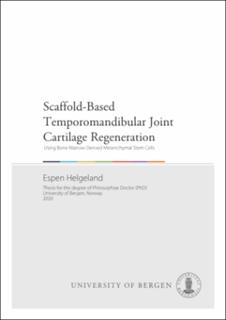| dc.description.abstract | Reconstruction of lost or damaged cartilaginous structures of the temporomandibular joint (TMJ) presents a clinical challenge and current treatment options are limited. The potential for repair is poor, because cartilage is avascular and degenerated structures are traditionally surgically removed, to improve function and reduce the level of pain. The studies in this thesis were undertaken to explore the possibility for regeneration of TMJ cartilage by means of tissue engineering (TE). The main objective of this thesis was to develop a regenerative approach for degenerated TMJ cartilage, combining bone marrow-derived stem cells (BMSC) with a natural polymer scaffold.
Study I is a pilot study, investigating the in vivo effect of the angiogenesis inhibitor, angiostatin, on BMSC seeded collagen scaffolds. After subcutaneous implantation in rats for two weeks, angiostatin downregulated the levels of inflammatory and angiogenic gene markers and decreased vessel formation in the constructs. However, histological examination disclosed that this strategy alone did not induce cartilage formation.
Based on the above findings, and the observed lack of established methods for TMJ cartilage TE, a systematic literature review (Study II) was undertaken to assess the in vivo evidence for TMJ TE. In total, the search yielded 30 studies of ectopic and orthotopic models investigating regeneration of the TMJ disc, condyle, and synovial membrane, in five different species. Overall, the use of BMSC and natural polymer scaffolds was most frequently reported. With respect to regenerative potential, differentiated stem cells were reported to be superior to undifferentiated cells.
The systematic review disclosed the beneficial effects of BMSC combined with scaffolds of natural polymers, such as collagen and gelatin. With respect to TMJ regeneration by TE, the preferred scaffolding material for investigation was gelatin, because of its biocompatibility, superior hydrogel-forming properties and lower costs in comparison with collagen. In Study III, a gelatin hydrogel was 3D printed, crosslinked with genipin and characterized in terms of swelling, stability, degradation, mechanical properties and cytotoxicity. The chondrogenic differentiation potential of human BMSC (hBMSC) seeded on the developed scaffolds was compared with that of hBMSC in traditional pellet or novel spheroid cultures. Genipin successfully prevented rapid degradation of the scaffolds, which supported cell attachment and proliferation without adverse cytotoxic effects. Scaffolds seeded with hBMSC followed the same trend in upregulation of chondrogenic gene markers, but at lower levels than for pellet and spheroid cultures. It was noteworthy that the hypertrophy marker collagen type 10 was downregulated in hBMSC on scaffolds, in comparison with spheroids and cell pellets. The chondrogenic differentiation of hBMSC on the 3D printed scaffolds was confirmed by Alcian blue and immunofluorescence staining.
In Study IV, dehydrothermal (DHT) treatment was compared to ribose and the dual crosslinking with both DHT and ribose. The scaffolds were characterized with respect to swelling, stability, enzymatic degradation, and degree of crosslinking. Cell-seeding efficiency, attachment, proliferation, glycosaminoglycan (GAG) formation and differentiation of rat BMSC were compared between the groups. While the dual crosslinking resulted in the highest degree of crosslinking, stability, enzymatic resistance, mechanical properties, and proliferation, DHT had the highest cell seeding efficiency and viability. Ribose had the highest swelling capacity, but the lowest stability, enzymatic degradation, mechanical properties, cell seeding density and chondrogenic differentiation potential. However, no differences were observed with respect to GAG formation.
In summary, inhibition of vascularization alone was not enough to stimulate chondrogenesis in TE constructs (Study I), indicating the need for alternative approaches. The current preclinical evidence clearly demonstrates the beneficial effects of using natural polymer scaffolds combined with MSC for TMJ TE (Study II). Gelatin, one such polymer, was found to be suitable for fabrication of 3D printed scaffolds, which support the proliferation and chondrogenic differentiation of hBMSC (Study III). Finally, dual crosslinking of 3D printed gelatin scaffolds with DHT and ribose enhanced the degree of crosslinking, mechanical properties, enzymatic resistance and stability (Study IV). | en_US |
